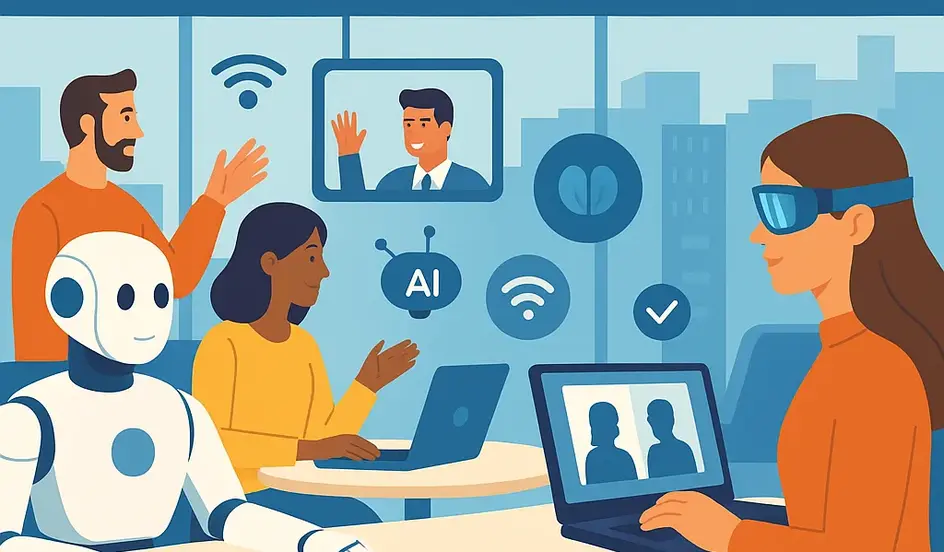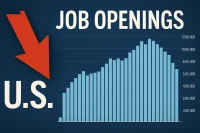The Unprecedented Acceleration of Workplace Technology
The pace of workplace technology adoption is accelerating at a rate never seen before in human history. While it took 30 years for computers to become mainstream in offices, email needed just 10 years, smartphones 5 years, and cloud computing a mere 3 years to revolutionize work. But what’s happening in 2025 is fundamentally different—we’re not just changing how we work but redefining what work means altogether.
These workplace technology trends aren’t incremental improvements; they represent complete transformations of what’s possible in our professional lives. To stay competitive and relevant, professionals must understand and adapt to these revolutionary changes happening right now.
5 Revolutionary Workplace Technology Trends Reshaping Professional Life in 2025
1. AI Collaboration Tools: Your New Intelligent Coworker
The workplace AI revolution has reached a staggering $18.5 billion market value in 2025, completely transforming creative and analytical work processes. These aren’t simple automation tools but sophisticated collaboration partners that enhance human capabilities.
Anthropic’s Claude 4 exemplifies this transformation, processing entire quarterly reports in seconds while providing insights that would have previously taken analyst teams days to compile. Its ability to understand context and nuance has become so sophisticated that it can adapt complex technical documents for different expertise levels while maintaining perfect accuracy.
Google’s Gemini Ultra pushes boundaries even further with processing speeds four times faster than in 2023. What’s truly remarkable is its ability to generate custom enterprise applications while simultaneously handling multimedia content creation.
According to McKinsey’s latest report, these AI advancements are saving companies an entire workday per employee per week—time now redirected toward innovation and strategic thinking.
How to stay ahead:
- Start treating AI as a collaborator rather than just a tool
- Begin experimenting with free versions of tools like Claude and Gemini
- Focus on learning prompt engineering and AI workflow integration
- Partner with AI to enhance your work rather than competing with it or avoiding it
2. Augmented Reality Workspaces: The New Office Experience
The AR market has soared to $35 billion in 2025, evolving far beyond simple visual overlays to create immersive work environments. This workplace technology trend is transforming how teams collaborate across distances.
Apple Vision Pro has significantly advanced how professionals can work in mixed reality environments. While the technology may not yet be comfortable for full-day use, it’s rapidly evolving in that direction, creating new possibilities for remote collaboration.
Meta Workspace AR has taken a different approach, focusing on creating incredibly lifelike virtual environments with photorealistic character representations and spatial audio that make remote work feel natural and engaging. This technology is poised to trigger another shift in work patterns, potentially reversing the recent return-to-office trend as virtual presence becomes increasingly sophisticated.
AR is already more integrated into our daily lives than many realize, with smartphones offering AR capabilities like measurement tools and navigation. This workplace technology trend represents a significant opportunity for professionals willing to invest in learning these new interaction paradigms.
3. Automated Task Management: The Rise of AI Agents
2025 is the year of AI agents—autonomous digital assistants capable of completing sequences of tasks without continuous human direction. This workplace technology trend is fundamentally changing workflow management across industries.
Unlike traditional automation tools, AI agents can initiate new tasks after completing previous ones, essentially functioning as personal assistants for coding, writing, video editing, and numerous other professional tasks. Major technology companies are racing to develop the most effective AI agent systems, creating intense competition in this space.
This shift requires professionals to adapt their skill sets. The days of specializing in just one or two valuable skills are ending. Tomorrow’s successful professionals will need multiple complementary skills—technical abilities paired with interpersonal capabilities like public speaking or teaching. Even skilled developers will need to emerge from their comfort zones to develop broader professional competencies.
4. Skill-Based Job Matching: The End of Traditional Resumes
The traditional resume has become obsolete as AI-powered skill matching transforms the hiring landscape. This workplace technology trend is creating more efficient and satisfying job placements for both employers and employees.
LinkedIn’s 2025 report reveals that 68% of hiring now happens through sophisticated AI systems analyzing everything from practical work samples to team compatibility. These platforms use neural networks to process vast amounts of data, creating comprehensive skill profiles that go far beyond traditional qualifications.
The impact on hiring efficiency has been remarkable:
- 45% decrease in bad hires
- More than 50% reduction in time-to-hire
- 35% increase in job satisfaction among candidates placed through these systems
These statistics suggest AI might understand career preferences better than candidates themselves do on paper. This workplace technology trend emphasizes the importance of continuously building different skills and maintaining strong professional networks, as individual skills may not be as valuable in isolation as they once were.
5. Personalized Learning Integration: Custom Skill Development
The workplace learning market has exploded to $500 billion globally as personalized learning becomes essential for professional development. This workplace technology trend is transforming how employees acquire new skills.
Corsair’s Enterprise Neural Tutor exemplifies this evolution, analyzing work patterns in real-time to create personalized learning paths that adapt to individual progress and learning styles. The platform predicts learning trajectories and optimizes training programs for maximum retention and practical application.
This represents a significant shift from static learning approaches of just a few years ago. Today’s learning systems are increasingly customized, helping professionals develop multiple interconnected skills rather than isolated competencies. Modern courses increasingly integrate complementary skills—teaching coding alongside communication skills, for example. Explore the latest in workplace learning at MIT Technology Review.
To leverage this workplace technology trend:
- Adopt a continuous learning mindset
- Complete diverse courses outside your primary expertise
- Stay curious and avoid limiting yourself to one professional identity
- Explore complementary skills that enhance your primary expertise
The Expanding Job Market: More Opportunities Than Ever
The most fascinating aspect of these workplace technology trends is how they’re reshaping the job market itself. According to the World Economic Forum’s latest research, for every job automated by these advances, 2.3 new positions are created.
We’re not just working differently—we’re creating entirely new categories of work. The future workplace isn’t about replacement but transformation, offering more exciting opportunities than we could have imagined just a few years ago.
Preparing for the 2025 Workplace Technology Revolution
As these workplace technology trends accelerate, professionals must prepare strategically to thrive in this new environment:
- Develop AI literacy – Understanding how to work with AI tools is no longer optional but essential
- Cultivate uniquely human skills – Focus on creativity, emotional intelligence, and complex problem-solving
- Embrace continuous learning – Commit to regular upskilling and reskilling as technologies evolve
- Build complementary skill sets – Develop expertise across multiple domains rather than specializing too narrowly
- Adopt a growth mindset – View technological change as an opportunity rather than a threat
The workplace of 2025 rewards adaptability, curiosity, and willingness to engage with new technologies. By understanding these workplace technology trends and proactively developing relevant skills, professionals can position themselves for success in this rapidly evolving landscape.
Explore Careers in Emerging Tech Fields
Search the latest positions on WhatJobs – Discover roles in industries being transformed by next-gen workplace technology trends.
Explore Tech Jobs →FAQ: Understanding 2025’s Workplace Technology Trends
What are the most important workplace technology trends reshaping professional life in 2025?
The five most transformative workplace technology trends in 2025 are AI collaboration tools, augmented reality workspaces, automated task management through AI agents, skill-based job matching, and personalized learning integration. These technologies aren’t just changing how we work—they’re fundamentally redefining what work means by creating new possibilities for productivity, collaboration, and skill development.
How are workplace technology trends affecting job security and employment opportunities?
Contrary to fears about job loss, workplace technology trends are actually expanding employment opportunities. World Economic Forum research shows that for every job automated by these advances, 2.3 new positions are created. However, these new roles often require different skill sets than those being automated, emphasizing the importance of continuous learning and adaptability in the modern workplace.
What skills should professionals develop to thrive amid these workplace technology trends?
To succeed with emerging workplace technology trends, professionals should focus on developing AI literacy, cultivating uniquely human skills like creativity and emotional intelligence, embracing continuous learning practices, building complementary skill sets across multiple domains, and adopting a growth mindset that views technological change as an opportunity rather than a threat.
How can companies best implement these workplace technology trends to improve productivity?
Organizations can successfully implement workplace technology trends by taking a strategic approach that focuses on augmenting human capabilities rather than simply replacing workers. This includes investing in proper training programs, creating clear guidelines for human-AI collaboration, redesigning workflows to leverage new technologies, measuring outcomes beyond simple efficiency metrics, and fostering a culture that embraces technological innovation while valuing human contributions.




